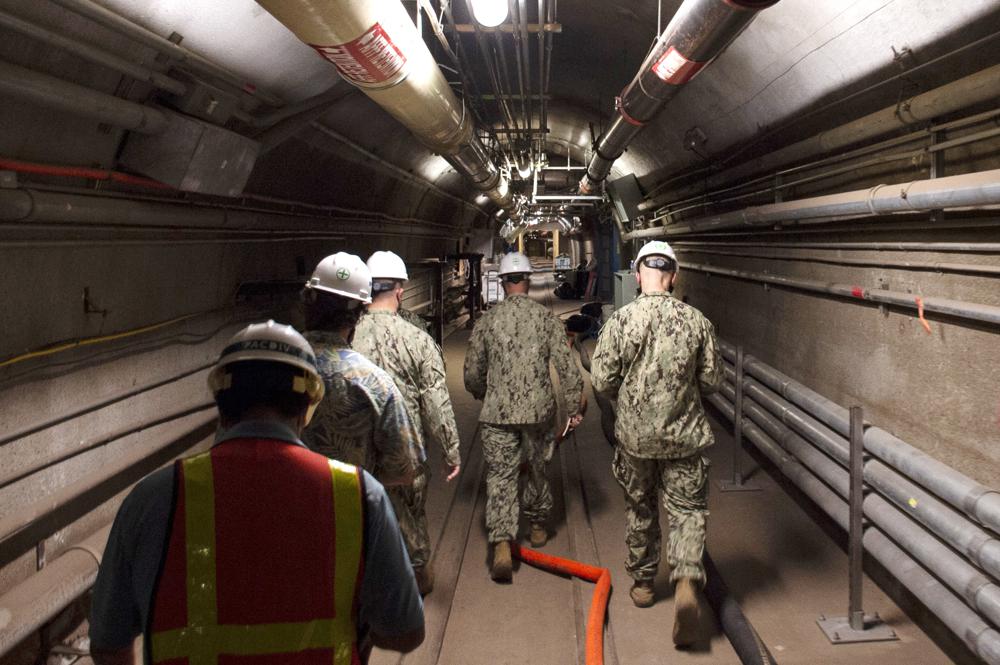The Defense Department will permanently shut down the Navy’s massive fuel tank facility in Hawaii that leaked petroleum into Pearl Harbor’s tap water, and will remove all the fuel, the Pentagon said Monday.
Pentagon press secretary John Kirby said the decision by Defense Secretary Lloyd Austin is based on a new Pentagon assessment, but also is in line with an order from Hawaii’s Department of Health to drain fuel from the tanks at the Red Hill Bulk Fuel Storage Facility. The tanks, built into the side of a mountain during World War II to protect them from enemy attack, had leaked into a drinking water well and contaminated water at Pearl Harbor homes and offices.
Nearly 6,000 people, mostly those living in military housing at or near Joint Base Pearl Harbor-Hickam were sickened, seeking treatment for nausea, headaches, rashes and other ailments. And 4,000 military families were forced out of their homes and are in hotels.
Austin spoke with Hawaii government leaders on Monday to inform them of the decision, which he said will protect the population and the environment, and will also lay the groundwork for a more secure military fueling system.
“This is the right thing to do,” Austin said in a statement. “Centrally-located bulk fuel storage of this magnitude likely made sense in 1943, when Red Hill was built. And Red Hill has served our armed forces well for many decades. But it makes a lot less sense now. ”
He added that, “when we use land for military purposes, at home or abroad, we commit to being good stewards of that resource. Closing Red Hill meets that commitment.”
U.S. Sen. Mazie Hirono, D-Hawaii, said she has been encouraging the Pentagon to make that shutdown decision for weeks.
“I have said from day one that ensuring the health and safety of the residents of Oahu is my top priority and I share the community’s big sigh of relief with this news,” said Hirono, who is a member of the Senate Armed Services Committee.
The Pentagon said it will move to a more dispersed fueling system for military ships and aircraft in the Indo-Pacific. Based on the new assessment, the expanded system will be more cost effective and provide greater security by spreading the fuel supply more broadly across the region.
The new plan, laid out in recommendations delivered to Austin by a study group, would increase the fuel contracts that the U.S. has with other territories and nations in the Indo-Pacific, and add several more tanker ships that are based at sea. There are currently less than a dozen tanker ships, so several more would have to be built.
An assessment team that had been studying how to make the tanks safe to operate, will now shift and determine how to shut the tanks down and remove the fuel in an environmentally safe way. The team must report back to Austin by the end of April with recommendations.
Once the facility is able to operate again, the defueling will begin and is expected to take about a year. So, the entire defueling process could be finished some time next year. Austin has asked the Navy secretary to plan a budget for all necessary corrective action for any prior releases from the facility.
At the same time, Austin said the department will also work with state, national and local leaders to clean up the contamination and consider other uses for the property once the fueling plant is closed. And the military will also provide help to the families and workers affected.
“Your health has been impacted, your lives and livelihoods have been disrupted, and in many cases, your very homes have been rendered unavailable to you,” Austin said. “We owe you the very best health care we can provide, answers to your many questions, and clean, safe drinking water. Quite frankly, we owe you a return to normal. And you have my commitment to that end.”
The tanks can hold 250 million gallons of fuel, and they are at less than half capacity right now. Officials said that 13 of the 20 tanks have fuel in them, two others are permanently closed and five are in repair.
The giant U.S. government fuel storage installation, which has provided fuel to military ships and planes crisscrossing the Pacific Ocean since World War II, was a secret for years. The 20 fuel tanks were built into the mountain ridge to protect them from aerial attacks. Each tank is about the height of a 25-story building and can hold 12.5 million gallons (47.3 million liters.)
The tanks are connected to underground pipelines that send fuel about 2.5 miles (4 kilometers) to Pearl Harbor and to ships and planes used by the Air Force, Army, Coast Guard, Marines and Navy.
The Navy hasn’t determined how petroleum got in the water. Officials are investigating a theory that jet fuel spilled from a ruptured pipe last May and somehow entered a fire suppression system drain pipe. They suspect fuel then leaked from the second pipe on Nov. 20, sending it into the drinking water well.
Once the leak was discovered, Hawaii state officials and members of Congress immediately began to demand the facility be shut down.
The Navy in early February appealed that order, and at the time Deputy Defense Secretary Kathleen Hicks said the appeal would give the military time “to make evidence-based and transparent decisions.”
Kirby on Monday said the department realizes this will not be a quick fix. “We have work to do,” he said. “But we do believe that this decision by the Secretary today marks a significant first step in the path forward.”
(AP)











